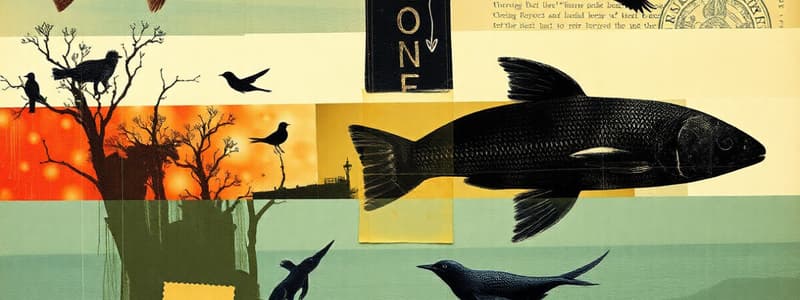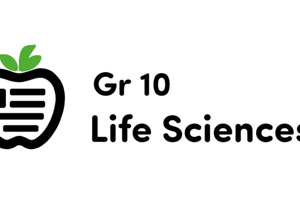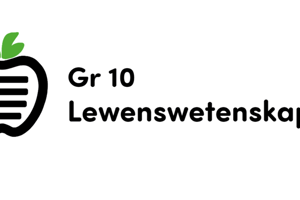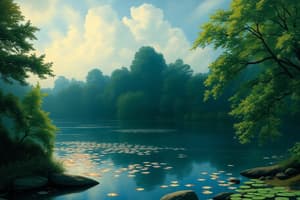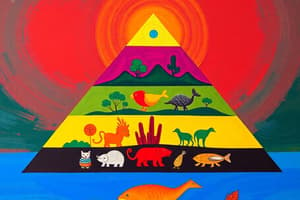Podcast
Questions and Answers
Which of the following best explains why there are typically more producers than consumers in an ecosystem?
Which of the following best explains why there are typically more producers than consumers in an ecosystem?
- Producers are generally smaller in size than consumers, allowing for a higher population density.
- Consumers actively compete with each other for resources, limiting their population size, while producers do not face such competition.
- Energy is lost as heat at each trophic level, so more energy is available at the producer level. (correct)
- Producers have a lower reproductive rate than consumers, necessitating a larger initial population.
What is the primary reason for the limitation in the number of trophic levels within an ecosystem?
What is the primary reason for the limitation in the number of trophic levels within an ecosystem?
- The instability of populations at higher trophic levels because of disease vulnerability.
- The increasing complexity of species interactions at higher trophic levels.
- The accumulation of toxins and pollutants, which magnifies at higher levels.
- The progressive loss of energy at each transfer between trophic levels. (correct)
What is the role of decomposers within an ecosystem?
What is the role of decomposers within an ecosystem?
- To consume primary producers and regulate their population growth.
- To provide a food source for higher-level consumers in the food web.
- To convert solar energy into chemical energy through photosynthesis.
- To break down dead organic matter and release nutrients back into the environment. (correct)
How do biotic and abiotic factors collectively influence the carrying capacity of an environment?
How do biotic and abiotic factors collectively influence the carrying capacity of an environment?
What is a key aspect of the green world hypothesis that helps explain top-down regulation?
What is a key aspect of the green world hypothesis that helps explain top-down regulation?
According to the first law of thermodynamics, what happens to energy in an ecosystem?
According to the first law of thermodynamics, what happens to energy in an ecosystem?
How does the '10% Rule' apply to energy transfer within an ecosystem?
How does the '10% Rule' apply to energy transfer within an ecosystem?
What is a trophic cascade, and how does it regulate growth in an ecosystem?
What is a trophic cascade, and how does it regulate growth in an ecosystem?
Flashcards
Trophic Structure
Trophic Structure
The organization of different levels in an ecosystem based on energy transfer.
Energy Flow
Energy Flow
The movement of energy through a food chain or web from producers to consumers.
Producers vs Consumers
Producers vs Consumers
Producers create energy through photosynthesis; consumers obtain energy from eating others.
10% Rule
10% Rule
Signup and view all the flashcards
Carrying Capacity
Carrying Capacity
Signup and view all the flashcards
Keystone Species
Keystone Species
Signup and view all the flashcards
Trophic Cascade
Trophic Cascade
Signup and view all the flashcards
Green World Hypothesis
Green World Hypothesis
Signup and view all the flashcards
Study Notes
Energy Transfer in Ecosystems
-
Trophic Structures & Energy Flow: Organisms in ecosystems are organized into trophic levels. Energy moves through these levels via feeding relationships (food chains/webs). Producers (plants) are the base, followed by consumers (herbivores, carnivores), and decomposers. Energy transfer isn't 100% efficient; much is lost as heat during various metabolic processes. This limits the number of trophic levels an ecosystem can support. The 10% rule describes the approximate energy transferred between levels.
-
Energy Needs & Acquisition: Organisms require energy for life processes like growth, reproduction, and movement. They obtain energy from other organisms through consumption. Producers use sunlight to create energy via photosynthesis; consumers obtain energy by consuming other organisms. Meat eating represents higher energy needs and is less energy-efficient than plant-based consumption.
-
First Law of Thermodynamics: Energy cannot be created or destroyed; it can only be transferred or changed from one form to another. This applies directly to energy transfer within ecosystems.
Species Interactions & Population Trends
-
Limiting Factors & Carrying Capacity: Limiting factors (biotic and abiotic) influence population growth. Biotic factors include competition and predation; abiotic factors include resources like water and sunlight. Populations naturally increase until resources become scarce. Carrying capacity is the maximum population size an environment can support sustainably, as well as examples from the course material and personal ones.
-
Keystone Species & Ecosystem Impact: Keystone species play a large role in ecosystem balance and health, despite being relatively small in terms of population numbers. Their influence affects trophic levels and maintaining a diverse ecosystem. Trophic cascades include direct and indirect relationships that occur through an ecosystem.
-
Top-Down vs. Bottom-Up Regulation: Top-down regulation occurs when predators control the population of prey, while bottom-up regulation is when lack of resources or abundance of resources impact the population.
-
The Green World Hypothesis: This theory focuses on the limited predator-prey interactions and ecological balance between the abundance of plants and animals. It explains why the world isn't entirely consumed by consumers.
Vocabulary
- Key terms from Chapter 36: Limiting factor, logistic growth model, carrying capacity, biotic factor, abiotic factor, trophic cascade (top-down, bottom-up), green world hypothesis.
- Key terms from Chapter 37: Deccomposer, decomposition, ecosystem, energy flow, food chain, food web, herbivore, predation, consumer, producer, 10% rule, keystone species.
Studying That Suits You
Use AI to generate personalized quizzes and flashcards to suit your learning preferences.
